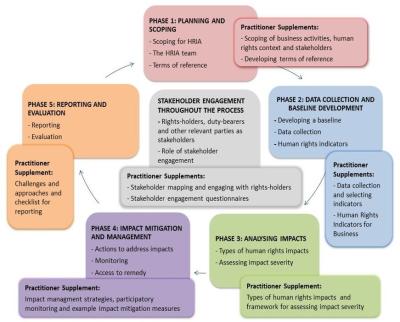Introduction to human rights impact assessment
In the business context, HRIA can be defined as a process for identifying, understanding, assessing and addressing the adverse effects of the business project or activities on the human rights enjoyment of impacted rights-holders such as workers and community members.
Engagement with rights-holders and other stakeholders is essential in HRIA. A thorough assessment of human rights impacts is unlikely to be possible or effective if conducted purely as a desktop research exercise. Instead, it is an involved process, requiring background research and fieldwork, as well as heavily based on the participation of rights-holders other stakeholders. Stakeholder engagement has therefore been situated as the core cross-cutting component in the Guidance and Toolbox.
- Human rights practitioners and consultants conducting impact assessments for business projects and activities
- Businesses, in particular staff who are responsible for commissioning and overseeing impact assessments
- Financial institutions providing support to businesses, in particular staff who are responsible for the implementation of social safeguard and performance standards
- National human rights institutions exercising their mandate to promote and protect human rights
- Government departments and state institutions that are responsible for providing guidance to businesses on respecting human rights or setting standards for due diligence
- Non-governmental and civil society organisations that support and/or represent workers, individuals and communities that are adversely affected by business projects or activities
- Other stakeholders with an interest in impact assessment and/or business and human rights
Phases of HRIA
HRIA involves several phases or steps, all of which need to be included to ensure a comprehensive assessment. In this Guidance and Toolbox, the phases have been divided into:

Click the image to enlarge
10 key criteria for HRIA
- Meaningful participation
- Non-discrimination
- Empowerment
- Transparency
- Accountability
- Use of human rights standards
- Analysis of actual and potential impacts (caused, contributed to and directly linked to)
- Assessment of severity of human rights impacts
- Inclusion of impact mitigation measures
- Focus on access to remedy
Welcome and Introduction guidance text
For more information on each criterion, as well as how these criteria are implemented in the HRIA process, see section A.5 in the full welcome and introduction text that includes information on:
- What is HRIA?
- Why do businesses need to assess their human rights impacts?
- How does HRIA relate to human rights due diligence and the UN Guiding Principles?
- How does HRIA relate to other human rights standards and initiatives?
- When should HRIA be undertaken and what factors can trigger a HRIA?
- How long does HRIA take?
- What are the differences and similarities between HRIA and other types of impact and risk assessment?
- Should HRIA be stand-alone or integrated?
- 10 key criteria for HRIA
For more information relevant to businesses interested in undertaking or commissioning HRIA, click here.
Environmental, social and health impact assessment practitioners interested in integrating human rights into impact assessment, click here.
To learn more about stakeholder engagement in HRIA, click here.
To go back to the landing page and explore the different phases of HRIA, click here.
